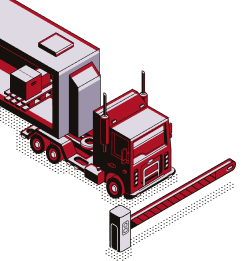Sea Freight Between the U.K. and the World
Sea freight remains the backbone of international trade, and the United Kingdom is one of its most strategic hubs. From Felixstowe and Southampton linking to Asia, to London Gateway and Liverpool connecting with Europe and North America, to Scottish and Northern Irish ports serving Ireland and beyond, DocShipper U.K. delivers tailored sea freight solutions that make global trade clear, reliable, and cost-effective.
Our role? To simplify the complexities of ocean shipping, ensuring your goods move securely, at competitive rates, and arrive on time, every time.



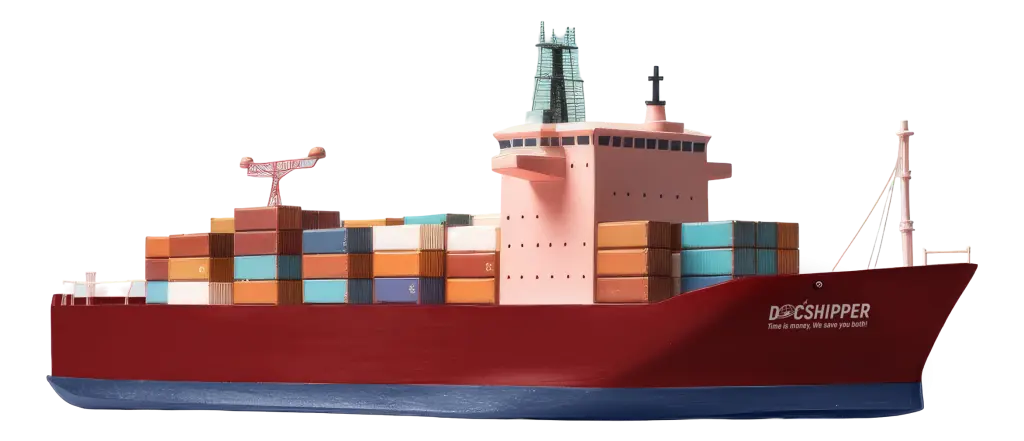
FCL and LCL: Our Traditional Container Shipping Solutions
Container shipping is the foundation of global trade, using standard 20ft and 40ft containers (including High Cube). Depending on your volumes, choose between FCL (Full Container Load) or LCL (Less-than-Container Load).
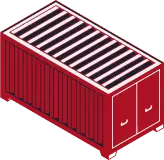
LCL (Less Than Container Load) - Container groupage
Ideal for smaller shipments.
- Share a container with other shippers.
- Pay only for the space you use.
- Cost-effective for low-volume freight.
- Flexible solutions tailored to your needs.
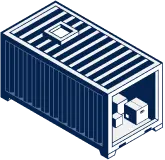
FCL (Full Container Load) - Full container
The best option for high-volume shipments.
- Entire container dedicated to your goods.
- Cost-efficient per unit shipped.
- Reduced handling by third parties, lowering risks.
- Faster delivery without extra stops.
Specialized Transport for your Special Cargo
Best for vehicles, machinery, or equipment that can roll on and off vessels.
Ro-Ro (Roll-on/Roll-off)
Perfect for shipping vehicles, trucks, or construction machinery.
Oversized Cargo
Tailored solutions for goods exceeding container dimensions (e.g. turbines, construction equipment).
Dry Bulk
For unpackaged commodities like grains, minerals, or coal.
Refrigerated Goods (Reefer)
Temperature-controlled containers for food, pharmaceuticals, and perishables.
Shipping Made Easy, From the UK to Anywhere
Worldwide Shipping
The U.K. is home to world-class container ports such as Felixstowe, Southampton, London Gateway, Liverpool, and Tilbury, handling millions of TEUs each year. From these strategic gateways, DocShipper U.K. connects importers and exporters to over 200 global markets, guaranteeing smooth access to the world’s main trade corridors, whether that’s Asia-Pacific, Europe, Africa, or the Americas.


Every Type of Cargo
Every shipment has its own requirements. Our expertise covers a wide spectrum of cargo: industrial machinery, oversized construction materials, refrigerated goods, consumer products, or even personal belongings during international relocations. With DocShipper U.K., each shipment is matched with the most suitable sea freight solution.


End-to-End Management
Sea freight is just one part of the journey. At DocShipper U.K., we manage the entire process in-house: from collecting goods and arranging HMRC export clearance, to port handling, ocean transit, customs at destination, storage if needed, and final delivery. With one partner overseeing every step, your shipment stays simple, secure, and fully transparent.


Paperwork Made Simple
Post-Brexit, paperwork has become more critical than ever. With DocShipper U.K., documents will never be the reason your goods are delayed at port. Our team prepares and verifies all required paperwork: to ensure compliance with HMRC regulations and destination customs, so clearance is smooth and stress-free.


Comprehensive Support Beyond Sea Freight
At DocShipper U.K., our role doesn’t stop at the port.
DocShipper’s approach is based on coordination rather than simply moving cargo. We centralise communication with freight forwarders, customs brokers, and local partners so that businesses don’t have to deal with multiple providers on their own. This coordination extends to compliance as well: we make sure all documentation, licenses, and customs requirements are handled properly in both the U.K. and the destination country.
We provide complete logistics support designed to integrate sea freight smoothly into your supply chain. Every business faces unique challenges, which is why our solutions go far beyond moving containers from port to port.


Customs Clearance
Our customs clearance specialists ensure that declarations, duties, and compliance checks are handled in line with HMRC requirements, preventing costly delays.

Last-Mile Delivery
For the final stretch, our trusted delivery partners take over, transporting your goods directly to warehouses, retail outlets, or even private addresses, ensuring reliability from the terminal to the end customer.

Storage
If your cargo requires storage, we offer flexible warehousing facilities close to major U.K. and international ports, whether for short-term consolidation or long-term stock holding.

Multimodal Service
For projects requiring broader coverage, we offer multimodal options that combine sea with air or road freight. This allows you to balance speed and cost, all managed by your dedicated DocShipper contact.
Your Sea Freight Shipments from/to the U.K., Managed from A to Z
Container shipping is the foundation of global trade, using standard 20ft and 40ft containers (including High Cube). Depending on your volumes, choose between FCL (Full Container Load) or LCL (Less-than-Container Load).


Steps of your Sea Cargo in the U.K.
Each shipment requires careful coordination. Here’s how we handle it.

Initial
contact
DocShipper team review your route, cargo, and deadlines, then provide a tailored and detailed quote within 24 hours.

Document
Verification
Commercial invoices, HS codes, packing lists, and licences are checked for compliance with U.K.
.

Goods Collection
We arrange pickup at your supplier, warehouse, Amazon FBA, or residence, and transfer the goods to the chosen port or terminal.

Export Customs Clearance
We manages the preparation of all HMRC export paperwork to ensure a smooth departure.

Handling at Origin
Cargo is received at the port, inspected if needed, consolidated, and carefully loaded onto the vessel.
,

Sea Transport
Docshipper experts monitor the voyage, manage schedule updates, and keep you informed at every milestone.

Handling at Destination
Once discharged, the container or cargo is moved to the terminal or CFS and prepared for release and onward transport.

mport Customs Clearance
Local customs formalities are processed, duties and VAT are settled, and any inspections are coordinated.

Final Delivery
Last-mile delivery by Docshipper is arranged to your warehouse, retail store, fulfilment centre, or residence, safely and on time.
Why choose DocShipper UK
Real-Time Tracking
Follow your container’s journey from origin to final delivery with full transparency at every stage.
24/7 Support
Our U.K. and global teams are always available, ensuring that questions or issues are addressed without delay.
Competitive Pricing
Thanks to strong carrier partnerships and high shipment volumes, we secure advantageous rates for both FCL and LCL while maintaining service quality.
Personalized Support
Every shipment is unique. A dedicated logistics consultant studies your project and tailors the shipping plan to your needs, deadlines, and budget.
+9,252 +
Clients9200 +
Operations+3,414 +
Sea freight operations+200 +
Countries covered by our networkClients Testimonials
We can't make this up - See why businesses worldwide trust us with their shipments every day.
I contacted DocShipper to organize the import of board games from Asia to Switzerland. Despite my lack of experience in the field and the modest size of my request, my dealings with the staff were always professional and efficient. I received sound advice and the staff always took the time to answer my questions. I look forward to working with DocShipper for the import of my goods and highly recommend their services.
Mavrik Grangier
December 10, 2024My name is Ad Van Den Bosh. I am a Dutch business man cross-trading in the Far East. I reached Robert Houwayek (DocShipper's representative) to clear a 40HC of greenhouse equipment from Qingdao, and deliver it to Lan Krabue in no time. He suggested that I request a Form E, which I did from the supplier, and was able to enjoy a preferential tariff treatment. DocShipper, a way to help you save both time and money!!
Ad van den Bosch
March 5, 2024I recently used Docshipper to ship my appliances from Germany to Thailand, and I'm thrilled with the service I received! [...]The team was professional, responsive, and kept me informed every step of the way. The packaging and handling of my appliances were top-notch, and they arrived in perfect condition. I was impressed with the attention to detail and care taken to ensure a safe and successful transport. I really recommend Docshipper for it.
Chemmie Chatuphorn
November 28, 2024In the event of goods being stuck at customs, Robert [...] is a customs broker you should arguably consider to release your cargo. Once I knew that my scale modeling tools coming from Spain are being withheld at Suvarnabhumi Airport, I resorted to him to release it and handle the last mile delivery. All what he asked me is to send 2 emails to be able to do it! [...] Well guess what, within 48 hours, it was done! I got my parcel at my place in Phuket.
Chan chan
Mar 5, 2024A vice president caught up in the thick of thin things, an EXW shipment of plumbing supplies for irrigation from Eureka California to Costa Rica is definitely not what I’d like to have on my agenda. Robert’s hang-in-there posture toward any arising challenges in shipping. [...] skillfully handled all US export formalities incl. SED/AES filing, not to mention the sea freight from Oakland POL. Everything ended up working out like a charm!
Dave Sheppard
July 10, 2024I feel they covered everything. DocShipper shipped a 20- ft Milvan overseas to Laem Chabang for a customer. The team was responsible for shipping the shipping to another country. Having very little knowledge in this area, I didn't know how to organise myself . One week after my arrival on the Asian continent. Marc O. Was available at all times and nearly instant feedback. Made a stressful event much easier and he definitely knows his job.
Anonymous, Indiana
Aug 9, 2023No More Stress Over Your Sea Shipments
From pickup to delivery, DocShipper U.K. manages every detail, while you focus on your business.
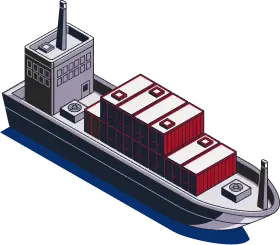
When to choose (or not) Sea freight from the UK
Although widely popular, ocean shipping isn’t always the best transport option.
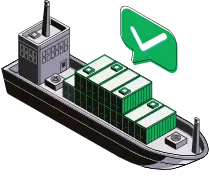
When to choose?
- Economical for large volumes
- Heavy or oversized goods
- Non-urgent shipments
- Long-distance international transport
- Non-perishable goods
- Goods requiring minimal handling
- Products resistant to climate changes
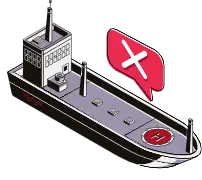
When to avoid?
- Urgent shipments
- For short or local transportation distances
- High-value or sensitive goods
- When enhanced security is needed
- Limited access to port infrastructure
- Frequent small-volume shipments
- Complex or short supply chains
- Seasonal demand fluctuations
The essential documents
for sea freight shipments
To ensure your goods travel in full compliance, several documents are essential.
- Bill of Lading
- Packing List
- Certificate of Origin
- Commercial Invoice
- Insurance Certificate
- Import/Export License
FAQ | UK sea freight
Where do you want to ship your goods?
Your next (or first) sea freight shipment deserves to be simple, fast, and hassle-free. With DocShipper U.K., you get full support and competitive pricing.



